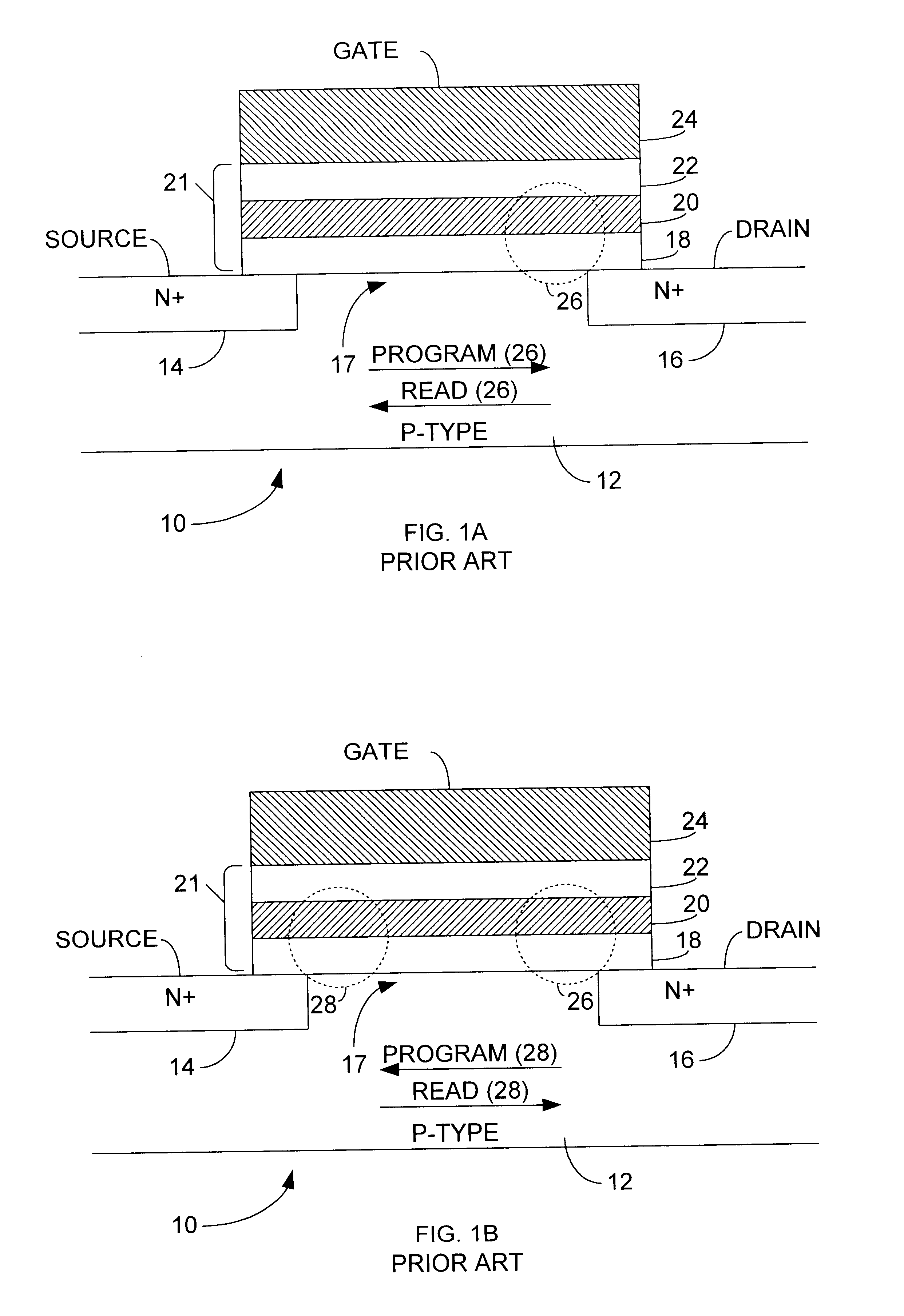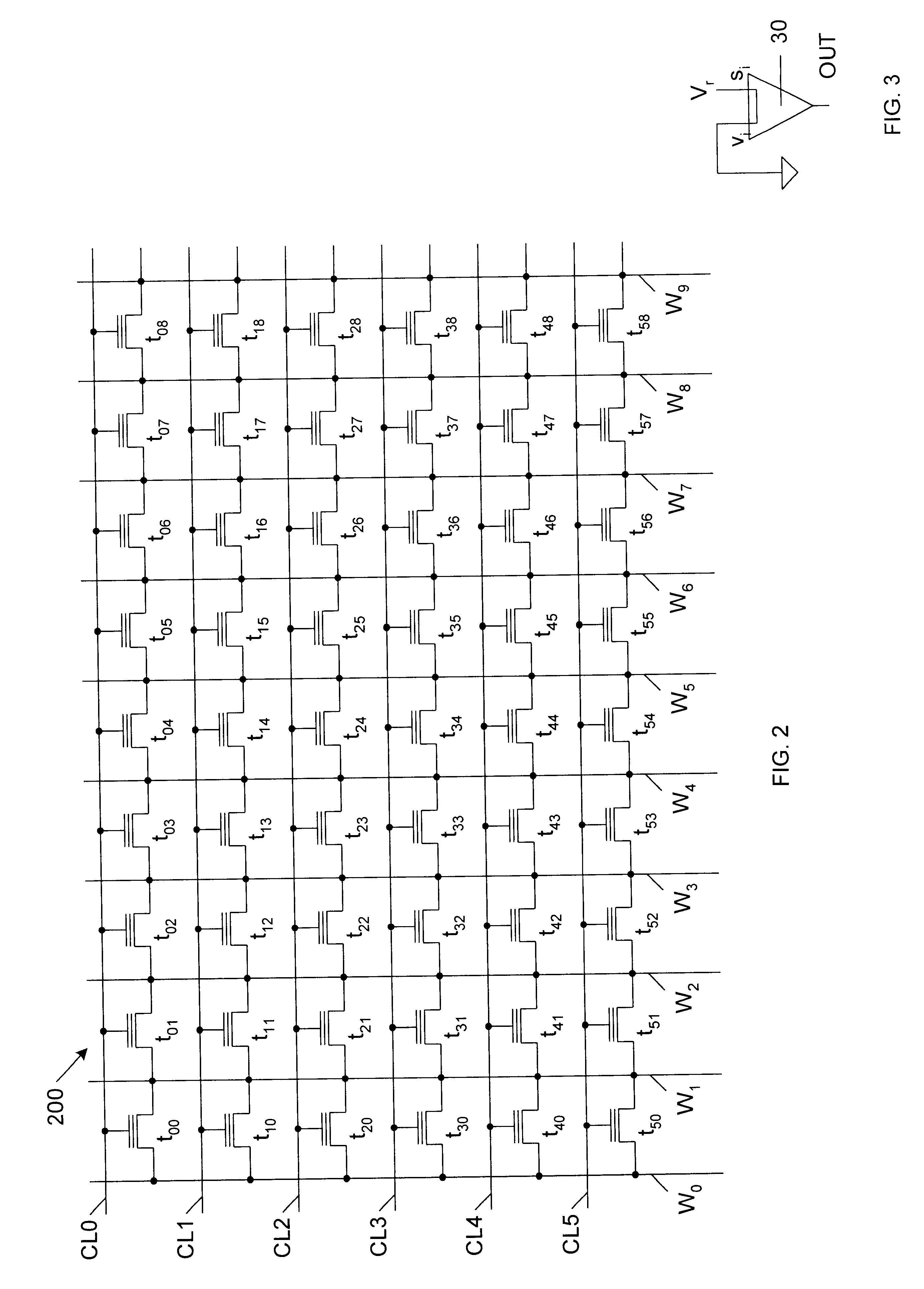Content-addressable memory for virtual ground flash architectures
a content-addressable memory and virtual-ground technology, applied in the field of non-volatile content-addressable memory arrays, can solve the problem of complex tasks for non-volatile memory arrays that implement virtual-grounds
- Summary
- Abstract
- Description
- Claims
- Application Information
AI Technical Summary
Benefits of technology
Problems solved by technology
Method used
Image
Examples
first embodiment
The first embodiment of the present invention will now be described in detail, with reference to FIG. 4.
FIG. 4 is a circuit diagram of a non-volatile content addressable memory (NVCAM) 400, which is implemented using array 200 (FIG. 2). Compare lines CL0-CL5 are coupled to receive compare bits C0-C0#, C1-C1# and C2-C2#, respectively. Word lines W0, W3, W6 and W9 are connected to receive a ground supply voltage (GND). Word lines W1, W2, W4, W5, W7 and W8 are coupled to the s.sub.i input terminals of sense amplifiers 30.sub.1 -30.sub.6, respectively. The v.sub.i input terminals of sense amplifiers 30.sub.1 -30.sub.6 are coupled to receive a reference voltage v.sub.r of about 2 Volts. Sense amplifiers 30.sub.1 -30.sub.6 provide output signals D1-D6, respectively.
In the first embodiment, the number of words in NVCAM array 400 is equal to the number of word lines minus one, times 2 / 3 (e.g., 2 / 3.times.(10-1)=6 words), and the number of bits per word is equal to 1 / 2 of the number of compar...
second embodiment
A second embodiment of the present invention will now be described. Like the first embodiment, the second embodiment can use either conventional floating gate non-volatile memory transistors or 2-bit non-volatile memory transistors (with only one bit of the 2-bit non-volatile memory transistors being used).
FIG. 5 is a circuit diagram of a non-volatile content addressable memory (NVCAM) 500, which is implemented using array 200 (FIG. 2). Compare lines CL0-CL5 are coupled to receive compare bits C0-C0#, C1-C1# and C2-C2#, respectively. Word lines W1, W5 and W9 are connected to receive a ground supply voltage (GND). Word lines W0, W2, W3, W4, W6, W7 and W8 are coupled to the s.sub.i input terminals of sense amplifiers 50.sub.1 -50.sub.7, respectively. Sense amplifiers 50.sub.1 -50.sub.7 provide output signals to logic blocks LB.sub.1 -LB.sub.9 as illustrated. Each of sense amplifiers 50.sub.1 -50.sub.7 is identical to sense amplifier 30 (FIG. 3). Each of logic blocks LB.sub.1 -LB.sub.9...
third embodiment
A third embodiment of the present invention will now be described. It should be noted that the first and second embodiments can use either conventional floating gate non-volatile memory transistors or 2-bit non-volatile memory transistors (with only one bit of the 2-bit non-volatile memory transistors being used). In contrast, the third embodiment requires 2-bit non-volatile memory transistors, which include left and right charge trapping regions that can be independently programmed and read as described above in FIGS. 1A and 1B. It is one purpose of the third embodiment to utilize two bits per storage device, thereby multiplying the density of the resulting NVCAM array two-fold as compared to the first embodiment. In accordance with the third embodiment, array 200 is able to support six 6-bit words (as compared with six 3-bit words in the first embodiment).
FIG. 6 is a circuit diagram of a NVCAM array 600 in accordance with the third embodiment of the present invention. NVCAM array ...
PUM
 Login to View More
Login to View More Abstract
Description
Claims
Application Information
 Login to View More
Login to View More - R&D
- Intellectual Property
- Life Sciences
- Materials
- Tech Scout
- Unparalleled Data Quality
- Higher Quality Content
- 60% Fewer Hallucinations
Browse by: Latest US Patents, China's latest patents, Technical Efficacy Thesaurus, Application Domain, Technology Topic, Popular Technical Reports.
© 2025 PatSnap. All rights reserved.Legal|Privacy policy|Modern Slavery Act Transparency Statement|Sitemap|About US| Contact US: help@patsnap.com



